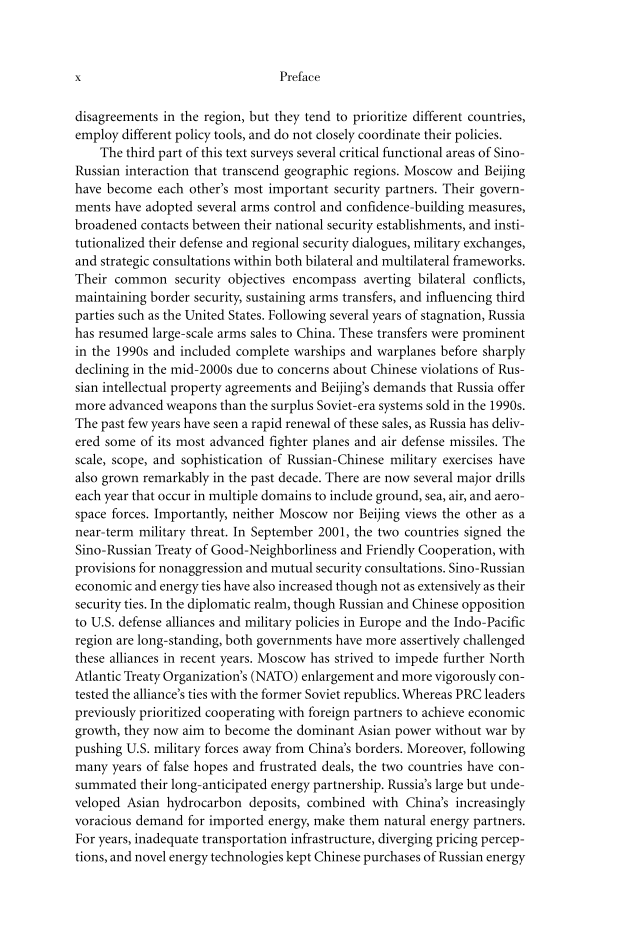x Preface disagreements in the region, but they tend to prioritize different countries, employ different policy tools, and do not closely coordinate their policies. The third part of this text surveys several critical functional areas of Sino- Russian interaction that transcend geographic regions. Moscow and Beijing have become each other’s most important security partners. Their govern- ments have adopted several arms control and confidence-building measures, broadened contacts between their national security establishments, and insti- tutionalized their defense and regional security dialogues, military exchanges, and strategic consultations within both bilateral and multilateral frameworks. Their common security objectives encompass averting bilateral conflicts, maintaining border security, sustaining arms transfers, and influencing third parties such as the United States. Following several years of stagnation, Russia has resumed large-scale arms sales to China. These transfers were prominent in the 1990s and included complete warships and warplanes before sharply declining in the mid-2000s due to concerns about Chinese violations of Rus- sian intellectual property agreements and Beijing’s demands that Russia offer more advanced weapons than the surplus Soviet-era systems sold in the 1990s. The past few years have seen a rapid renewal of these sales, as Russia has deliv- ered some of its most advanced fighter planes and air defense missiles. The scale, scope, and sophistication of Russian-Chinese military exercises have also grown remarkably in the past decade. There are now several major drills each year that occur in multiple domains to include ground, sea, air, and aero- space forces. Importantly, neither Moscow nor Beijing views the other as a near-term military threat. In September 2001, the two countries signed the Sino-Russian Treaty of Good-Neighborliness and Friendly Cooperation, with provisions for nonaggression and mutual security consultations. Sino-Russian economic and energy ties have also increased though not as extensively as their security ties. In the diplomatic realm, though Russian and Chinese opposition to U.S. defense alliances and military policies in Europe and the Indo-Pacific region are long-standing, both governments have more assertively challenged these alliances in recent years. Moscow has strived to impede further North Atlantic Treaty Organization’s (NATO) enlargement and more vigorously con- tested the alliance’s ties with the former Soviet republics. Whereas PRC leaders previously prioritized cooperating with foreign partners to achieve economic growth, they now aim to become the dominant Asian power without war by pushing U.S. military forces away from China’s borders. Moreover, following many years of false hopes and frustrated deals, the two countries have con- summated their long-anticipated energy partnership. Russia’s large but unde- veloped Asian hydrocarbon deposits, combined with China’s increasingly voracious demand for imported energy, make them natural energy partners. For years, inadequate transportation infrastructure, diverging pricing percep- tions, and novel energy technologies kept Chinese purchases of Russian energy
Document Details My Account Print multiple pages
Print
You have printed 0 times in the last 24 hours.
Your print count will reset on at .
You may print 0 more time(s) before then.
You may print a maximum of 0 pages at a time.

























































































































































































































































































